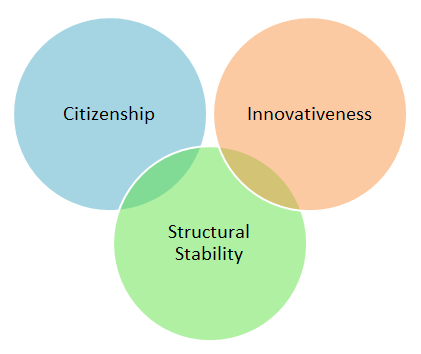How can not-for-profit organizations become Excellent NPOs?
We extracted 3 basic criteria of an Excellent NPO, based on the definition of the concept.
- Citizenship
- Innovativeness
- Structural Stability
The definition of Excellent NPOs is derived from the three challenges which the Japanese social sector currently faces.
The first challenge is to overcome weak ties between non-profit organizations and citizens.
The second challenge is to produce concrete outcomes and solutions for existing social issues.
The third challenge is to maintain stability in the organization's operations and activities.
The three criteria for becoming an Excellent NPO corresponds to the above mentioned challenges.
The Three Basic Criteria
________________________________________
Citizenship
The first criterion for an "Excellent NPO" is 'citizenship.'
'Citizenship' indicates the openness of an organization's activities to the public; in other words, this criterion measures whether a not-for-profit organization provides citizens with opportunities to participate in the organization's activities.
To be more specific, we check if the organization publicizes opportunities such as donating and volunteering in a way that is accessible to the wide public; we also check if the organization properly treats and manages donors and volunteers as participants of their activities.
These criteria correspond to the fact that many non-profit organizations in Japan currently lack strong ties with citizens. For example, many organizations rely heavily on governmental grants and business revenues. Even worse, many organizations do not promote volunteerism at all.
Innovativeness
The second criterion for an "Excellent NPO" is 'innovativeness.'
'Innovativeness' indicates the ability to propose and carry out solutions that works on the root cause of a social issue. We believe that this quality enables not-for-profit organizations to affect the wider public by improving citizens' quality of lives and leaving significant changes in mindsets or life-styles.
This criterion corresponds to the fact that many not-for-profit organizations in Japan lack innovation and renovation in their operations. In addition, many not-for-profit organizations lack mid-term and long-term management plans.
If not-for-profit organizations were to aim for "innovation" or "social change", they should aim for impact in the broader community. Although definitions of the words "innovation" or "social change" do not specify the size of the impacts they should bring, it seems safe to conclude that the size of the impact we anticipate in this context can well be nation-wide, or even international. Social impacts of such sizes tend to accompany drastic changes in existing customs, preconceived ideas and long-standing social systems. Therefore, in addition to providing social services, non-profit organizations should also be proactive in advocacy. The word 'advocacy' tends to be used interchangeably with 'policy recommendation' in Japan. However, what we mean by 'advocacy' in this context includes communicating on social issues to citizens.
Structural Stability
The third criterion for "Excellent NPOs" is 'structural stability.'
'Structural stability' indicates the ability to not only maintain continuous operations, but also to constantly review and improve its operations. Continuous operations alone do not count as performances of 'structural stability.'
This criterion corresponds to the challenges of overcoming unstable financial conditions, sustaining rules and ethics on receiving support and building a sound foundation for the organizations' activities.

Post a comment